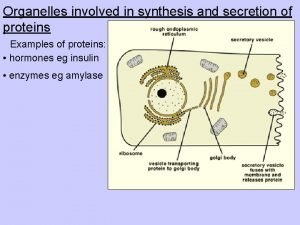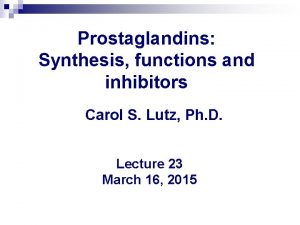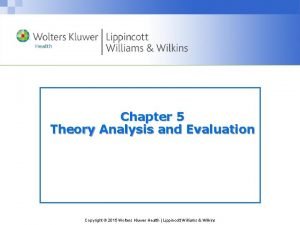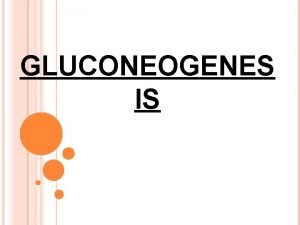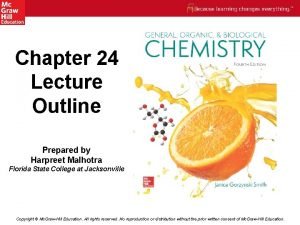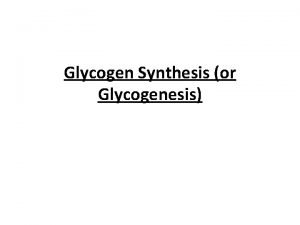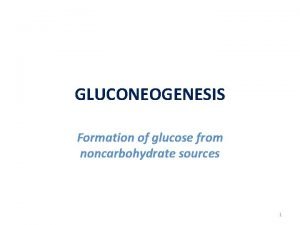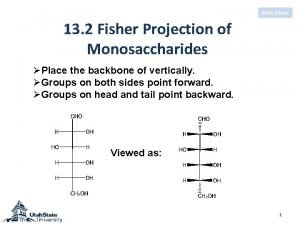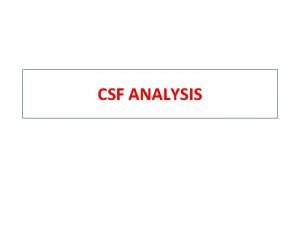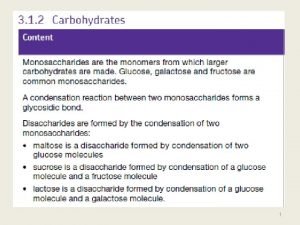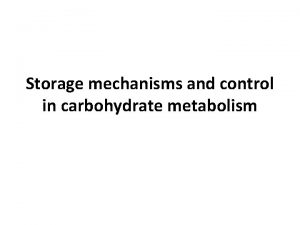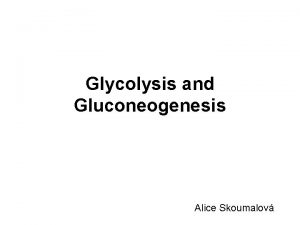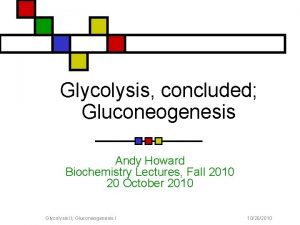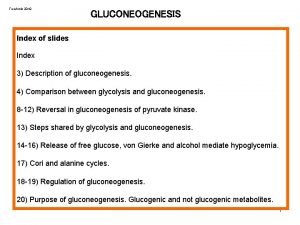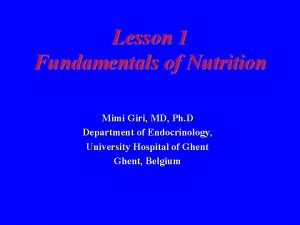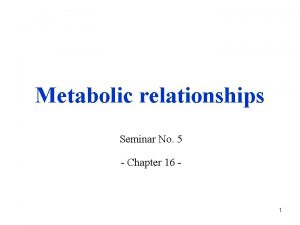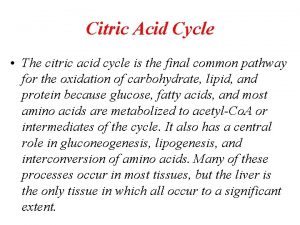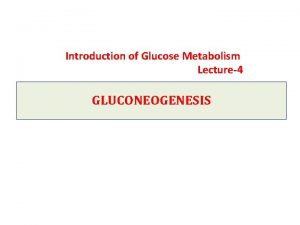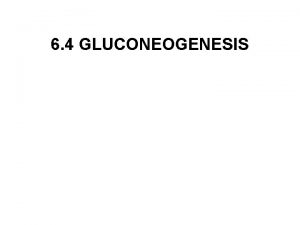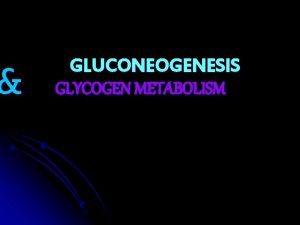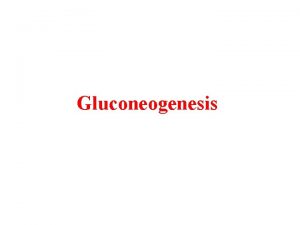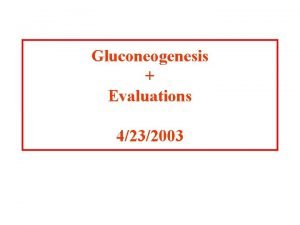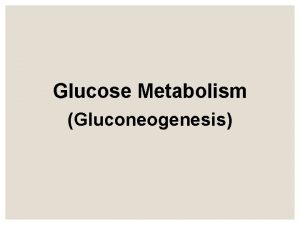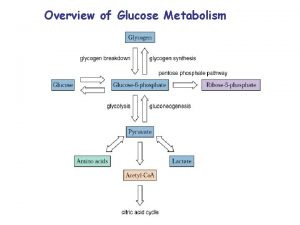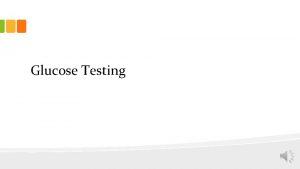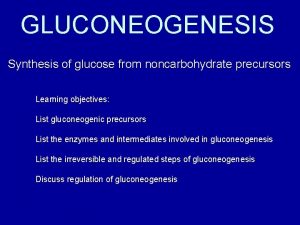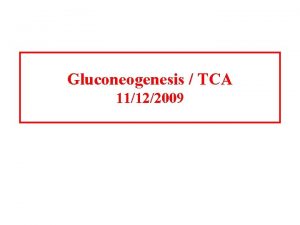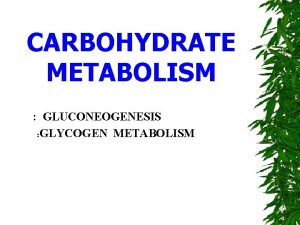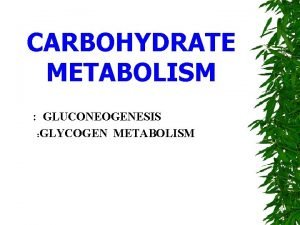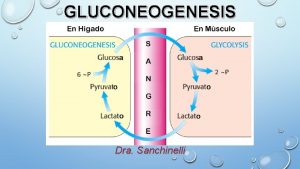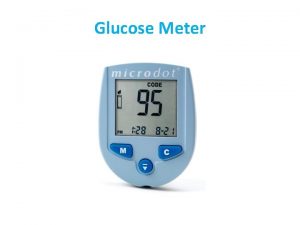22 7 Gluconeogenesis Glucose Synthesis Glucose is synthesized

















- Slides: 17

22. 7 Gluconeogenesis: Glucose Synthesis Glucose is synthesized in the tissues of the liver and kidneys. Tissues that use glucose as their main energy source are the brain, skeletal muscles, and red blood cells. Learning Goal Describe how glucose is synthesized from noncarbohydrate molecules. General, Organic, and Biological Chemistry: Structures of Life, 5/e Karen C. Timberlake © 2016 Pearson Education, Inc.

Utilization of Glucose is the primary energy source for the brain, skeletal muscle, and red blood cells. Glucose deficiency can impair the brain and nervous system. If our glycogen stores are depleted, • liver cells synthesize glucose by gluconeogenesis. • glucose is synthesized in the cytosol of the liver cells, and some is synthesized in the kidneys. General, Organic, and Biological Chemistry: Structures of Life, 5/e Karen C. Timberlake © 2016 Pearson Education, Inc.

Glycogen • can supply us with about one day’s requirement of glucose. • is made from glucose, most of which is synthesized in the cytosol of liver cells. To begin gluconeogenesis, carbon atoms from noncarbohydrate food sources are converted to pyruvate. General, Organic, and Biological Chemistry: Structures of Life, 5/e Karen C. Timberlake © 2016 Pearson Education, Inc.

Pyruvate to Phosphoenolpyruvate To start the synthesis of glucose from pyruvate, • two catalyzed reactions are needed to replace reaction 10 in glycolysis. • pyruvate carboxylase uses the energy of ATP hydrolysis to catalyze the addition of CO 2 to pyruvate and produce oxaloacetate. • phosphoenolpyruvate carboxykinase converts oxaloacetate to phosphoenolpyruvate. • phosphoenolpyruvate molecules now use enzymes to form fructose-1, 6 -bisphosphate. General, Organic, and Biological Chemistry: Structures of Life, 5/e Karen C. Timberlake © 2016 Pearson Education, Inc.

Pyruvate to Phosphoenolpyruvate General, Organic, and Biological Chemistry: Structures of Life, 5/e Karen C. Timberlake © 2016 Pearson Education, Inc.

Fructose-1, 6 -Bisphosphate to Fructose-6 Phosphate The second irreversible reaction in glycolysis is bypassed when fructose-1, 6 -bisphosphatase cleaves a phosphate group from fructose-1, 6 -bisphosphate. The product fructose-6 -phosphate undergoes the reversible reaction 2 of glycolysis to yield glucose-6 -phosphate. General, Organic, and Biological Chemistry: Structures of Life, 5/e Karen C. Timberlake © 2016 Pearson Education, Inc.

Glucose-6 -Phosphate to Glucose In the final irreversible reaction, the phosphate group of glucose-6 -phosphate is hydrolyzed by a different enzyme, glucose-6 -phosphatase, to form glucose. General, Organic, and Biological Chemistry: Structures of Life, 5/e Karen C. Timberlake © 2016 Pearson Education, Inc.

Glycolysis and Gluconeogenesis General, Organic, and Biological Chemistry: Structures of Life, 5/e Karen C. Timberlake © 2016 Pearson Education, Inc.

Energy Cost of Gluconeogenesis • The pathway consists of seven reversible reactions of glycolysis and four new reactions that replace three irreversible reactions. • Overall, glucose synthesis requires 4 ATPs, 2 GTPs, and 2 NADHs. General, Organic, and Biological Chemistry: Structures of Life, 5/e Karen C. Timberlake © 2016 Pearson Education, Inc.

Lactate and the Cori Cycle The Cori cycle • is the flow of lactate and glucose between the muscles and the liver. • occurs when anaerobic conditions occur in active muscle, and glycolysis produces lactate. • operates when lactate moves through the blood stream to the liver, where it is oxidized back to pyruvate. • converts pyruvate to glucose, which is carried back to the muscles. General, Organic, and Biological Chemistry: Structures of Life, 5/e Karen C. Timberlake © 2016 Pearson Education, Inc.

Lactate and the Cori Cycle General, Organic, and Biological Chemistry: Structures of Life, 5/e Karen C. Timberlake © 2016 Pearson Education, Inc.

Regulation of Gluconeogenesis is • not utilized when the diet is high in carbohydrates. • very active when the diet is low in carbohydrates. When conditions in a cell favor glycolysis, there is no synthesis of glucose. When the cell requires the synthesis of glucose, glycolysis is turned off. General, Organic, and Biological Chemistry: Structures of Life, 5/e Karen C. Timberlake © 2016 Pearson Education, Inc.

Regulation, Glycolysis, and Gluconeogenesis General, Organic, and Biological Chemistry: Structures of Life, 5/e Karen C. Timberlake © 2016 Pearson Education, Inc.

Metabolic Reactions of Glucose Glycolysis involves the breakdown of glucose, and gluconeogenesis involves the synthesis of glucose from noncarbohydrates. The pentose phosphate pathway converts glucose to ribose and provides NADPH. Glycogenolysis degrades glycogen to glucose whereas glycogenesis produces glycogen from glucose. General, Organic, and Biological Chemistry: Structures of Life, 5/e Karen C. Timberlake © 2016 Pearson Education, Inc.

Study Check Identify each process. 1) glycolysis 3) glycogenolysis 2) glycogenesis 4) gluconeogenesis A. the synthesis of glucose from noncarbohydrates B. the breakdown of glycogen into glucose C. the oxidation of glucose to two pyruvate D. the synthesis of glycogen from glucose General, Organic, and Biological Chemistry: Structures of Life, 5/e Karen C. Timberlake © 2016 Pearson Education, Inc.

Solution Identify each process. 1) glycolysis 3) glycogenolysis 2) glycogenesis 4) gluconeogenesis A. the synthesis of glucose from noncarbohydrates B. the breakdown of glycogen into glucose C. the oxidation of glucose to two pyruvate D. the synthesis of glycogen from glucose General, Organic, and Biological Chemistry: Structures of Life, 5/e Karen C. Timberlake 4) gluconeogenesis 3) glycogenolysis 1) glycolysis 2) glycogenesis © 2016 Pearson Education, Inc.

Concept Map General, Organic, and Biological Chemistry: Structures of Life, 5/e Karen C. Timberlake © 2016 Pearson Education, Inc.
 Proteins are synthesized in
Proteins are synthesized in Prostaglandins synthesized from
Prostaglandins synthesized from Synthesized method for theory evaluation
Synthesized method for theory evaluation Pyruvate to lactate
Pyruvate to lactate Glucose synthesis from non-carbohydrate sources
Glucose synthesis from non-carbohydrate sources Glycogenolysis youtube
Glycogenolysis youtube Formation of glucose from noncarbohydrate sources
Formation of glucose from noncarbohydrate sources Blood sugar god pod method
Blood sugar god pod method Dihydroxyacetone fischer projection
Dihydroxyacetone fischer projection Protein in csf
Protein in csf Alpha vs beta glucose
Alpha vs beta glucose Examples of physical function of art
Examples of physical function of art Precursor of gluconeogenesis
Precursor of gluconeogenesis Pasteur effect
Pasteur effect Pyruvate carboxylase
Pyruvate carboxylase Gluconeogenesis purpose
Gluconeogenesis purpose Gluconeogenesis from lactate
Gluconeogenesis from lactate Krebs cycle and gluconeogenesis
Krebs cycle and gluconeogenesis
